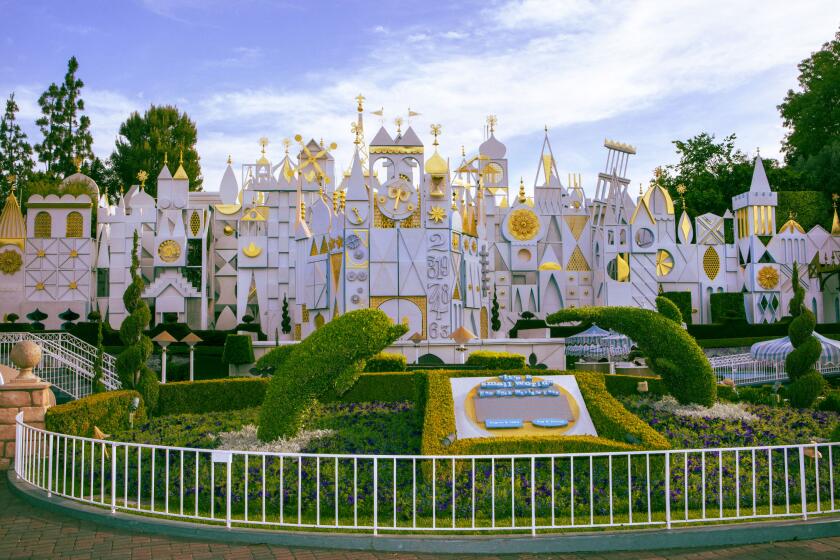L.A. passes law to clean the air
- Share via
Los Angeles embarked on one of its most ambitious projects to combat global warming on Monday, becoming the biggest city in the nation to impose “green” building rules that would potentially cut millions of tons of pollution over the next decade.
In a unanimous vote, the City Council passed an ordinance requiring builders of large commercial and residential developments to adopt such measures as planting drought-resistant landscaping and using recycled materials and energy-efficient heating, cooling and lighting.
Noting “the Los Angeles tradition of smog and sprawl,” Mayor Antonio Villaraigosa, wearing a green necktie in honor of Earth Day, signed the new law on a sunny terrace flanked by two model condominium high-rises, the Luma and the Elleven, off Hope Street in downtown, which were built to strict conservation standards.
The mayor has pledged to reduce the city’s carbon emissions 35% below 1990 levels by 2030, an effort that will also require a crackdown on the city’s coal-dependent municipal utility and a move toward electricity from renewable sources.
“We look toward the future through a greener lens,” Villaraigosa said, “after decades of poor policies that neglected environmental concerns.”
The law requires new commercial buildings and high-rise residential structures with more than 50,000 square feet of floor space to meet a nationally recognized “Leadership in Energy and Environmental Design” standard, developed by the U.S. Green Building Council, a Washington-based nonprofit. It also would cover major renovations and low-rise developments of 50 units or more.
City officials said about 150 new and renovated buildings, or about 7.5 million square feet, would be covered by the ordinance each year. The rules would amount to preventing about 85,000 metric tons of carbon dioxide emissions over the next five years, the equivalent of removing 15,000 cars from the roads.
Critics have compared the Los Angeles law unfavorably with an ordinance now before the San Francisco Board of Supervisors that would apply to all commercial and residential structures over 25,000 square feet and hold them to a stricter version of the building council’s standard than Los Angeles.
“We need lower thresholds to make a real, measurable change,” Richard Ludt, administrator of Interior Removal Specialist, a contractor, told the council Monday. His company handled 1,120 demolition projects in the city last year. Only eight of those projects would have fallen under the new ordinance’s recycling provisions, he said.
Philip A. Williams, a vice president at Webcor, which is building a massive development at Hollywood Boulevard and Vine Street, said the L.A. standards are weaker than San Francisco’s because they do not require an outside audit to verify promised greenhouse gas reductions. City officials say they will scrutinize every seventh application and intervene if violations are found, but Williams said, “Without third-party verification, it just means you tried your best.”
Villaraigosa sought to downplay divisions among city developers by inviting Mary Leslie, president of the Los Angeles Business Council, to endorse the new law at his news conference. She praised the law’s “sensible timeline and reasonable goals,” saying it “represents a tidal change in the way we perceive green building in L.A.”
Experts say that costs for building to the basic Leadership in Energy and Environmental Design standard are no higher than regular building costs. James Atkins, developer of the Luma, said that it cost his company, the South Group, about 1% more to build to an even higher “gold” standard, but that such costs are recouped through lower operating expenses.
On the other side of the spectrum, Holly Schroeder, chief executive of the Los Angeles/Ventura Chapter of the Building Industry Assn., told the council that it was illegal for the city to rely on Leadership in Energy and Environmental Design standards, and that cities can change building codes only “for climatic, geologic or topographic conditions.”
The final ordinance, Councilwoman Jan Perry said, “was a nod to the sensitivity of the real estate market” in Los Angeles. “We had opposition down here that maybe San Francisco didn’t experience.”
However, the council ordered staff to report back within six months as to whether a stricter standard should be adopted. “We will continue to push the envelope,” said Council President Eric Garcetti. He said he expects that “in a couple of years, every single building over 25,000 square feet will be covered” by the new law. By this summer, he said, the city expects to raise the bar for its municipal construction to Leadership in Energy and Environmental Design “silver” -- a higher standard that would match San Francisco’s threshold.
So far, one state, Connecticut, and 14 cities are requiring private developers to meet green building standards.
“The world,” Villaraigosa said, “is following in our footsteps.”
--
More to Read
Sign up for Essential California
The most important California stories and recommendations in your inbox every morning.
You may occasionally receive promotional content from the Los Angeles Times.











